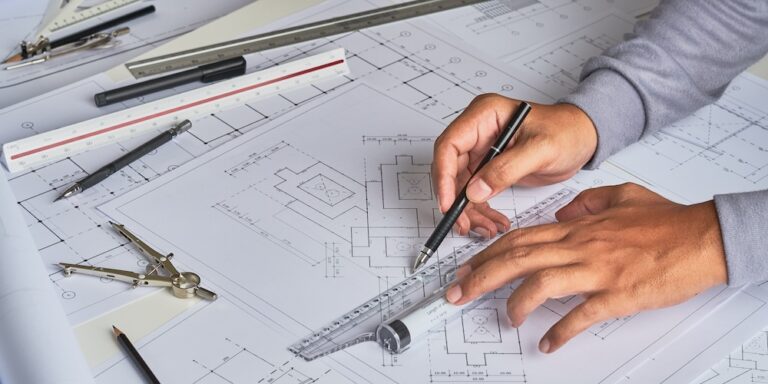— 12 min read
Schematic Design in Construction: Establishing the Vision with SD Drawings


Last Updated Aug 7, 2025

Mary Carroll-Coelho
Product Operations
12 articles
Mary Carroll-Coelho is a Product Operations Manager at Procore. A licensed Architect, Mary previously worked for KieranTimberlake, an architecture firm in Philadelphia, in construction and product operations at WeWork, and Director of Customer Success at Willow. She holds a Master of Architecture from the University of Pennsylvania. Outside of work, she volunteers as a mentor in the Spark program.

Taylor Riso
Contributing Writer
91 articles
Taylor Riso is a marketing professional with more than 10 years of experience in the construction industry. Skilled in content development and marketing strategies, she leverages her diverse experience to help professionals in the built environment. She currently resides in Portland, Oregon.
Last Updated Aug 7, 2025

Every construction project begins with a vision, but turning that vision into reality involves numerous steps and considerations. How will the spaces flow and interact? What design elements will best meet the project's goals? How can stakeholders ensure the project's feasibility and alignment with client expectations? These foundational questions are addressed during the early stages of project planning.
The approach to this schematic design phase can vary greatly, depending on the project's scope, the design team's methodology and the client's requirements. Understanding the nuances of this stage is important for avoiding design pitfalls and laying the path for a smooth progression through the subsequent stages of design and construction.
In this article, we will look into the intricacies of schematic design in construction, highlighting its importance and exploring the process.
Table of contents
What is schematic design?
Schematic design, or SD for short, is one of the earliest phases of the architectural design process. This phase involves creating early construction documents, moving beyond preliminary sketches to offer a structured representation of the project. These documents incorporate inputs from the entire architectural team, including key engineering consultants.
The primary purpose of schematic design is to document the key architectural and engineering elements that capture the project's vision and requirements. From the architect's perspective, they are flushing out the parti of the building.
For instance, while detailed structural elements are not fully fleshed out, the schematic design makes sure that the building has walls in the right place, circulation paths roughly worked out and a basic structure and systems in place, avoiding the impracticality of a "floating building" and any skyhook jokes that the structural engineering team will make.
Schematic design is also the phase where the design team begins to integrate the client's input, often using information from feasibility studies or master plans. These plans and studies often impact the building footprint, volume and other site considerations, like overall building orientation and entrance location.
Schematic Design vs. Other Design Phases
Schematic design stands apart from other phases of the design process, design development and construction documents, by its distinct focus on conceptualization and early-stage planning. Unlike the later phases, which delve into details and precise specifications, schematic design drawings provide a broad, less detailed overview that sets the initial direction for the project.
In the schematic design phase, the emphasis is on defining the project's basic layout and overall concept. This involves creating preliminary construction drawings that capture the essential elements and spatial relationships without going into the minutiae of minor material selection choosing each type of finish,, detailing each intersection.
For example, while later phases will specify the types and locations of mechanical systems and structural components in great detail, the schematic design will only broadly outline these elements so that the basic framework is understood and agreed upon.
Transitioning to Design Development and Construction Documents
The design development phase builds upon the foundations laid during schematic design. It involves refining the project's details, such as selecting materials, defining structural components, and integrating systems like HVAC, plumbing, and electrical. The documents produced in this phase are more detailed and precise, bridging the gap between the broad concepts of schematic design and the comprehensive specificity of construction documents.
Construction documents represent the final phase before bidding starts on a project. This phase produces highly detailed drawings and specifications that contractors use to build the project. Every aspect of the design is fully fleshed out, from the exact placement of every wall and window to the specific materials. These documents are important for ensuring that the project is built according to the design intent and meets all regulatory and safety standards.
Initiating the Schematic Design Phase
The schematic design phase is typically the first formal step in transforming a project's vision into a concrete plan. This is normally the moment when an architectural firm is contracted to bring the building from concept, through the drawings and design phases, to 100% construction documents for bidding to contractors.
Owner Project Approval and Funding
The schematic design phase typically begins once the owner has received initial approval and funding for the project. This approval marks the transition from conceptual discussions to formal planning, where the design team can start to develop a tangible representation of the project. This phase sets the project on a solid foundation, so that all stakeholders are aligned with the project's vision and goals.
Gathering Information
The process often starts with the architect and design team gathering information from various sources such as feasibility studies, master plans or client directives. Larger clients, such as universities or municipalities, often have master plans that provide a comprehensive roadmap for future developments. These master plans are invaluable as they outline the broader context within which the new project will be developed, including zoning, site conditions, and long-term strategic goals. It's important to understand the client's existing plans, their requirements and how this project fits in.
Role of the Architectural Team
Similarly to GCs and Subs, the architect is the main contract holder with the client. The architect, along with their partner engineering firms and other key consultants, typically submit a joint proposal to the client. However, the architect is generally the main contract holder. This setup is common for building design projects.
In contrast, large civil or landscape projects might have a different arrangement. For example, if someone were to create another Central Park, it would be common for a landscape architectural firm to hold the main contract.
Early collaboration with engineering consultants is a key part of this to ensure the feasibility of the proposed design. Engineers provide critical input on structural integrity, mechanical systems and compliance with zoning regulations. This collaborative approach helps in identifying potential challenges early on and allows for adjustments before moving into more detailed phases of design, preventing costly revisions and laying the path for a smoother project delivery.
Key Components of Schematic Design
During the schematic design phase, several key elements are established that guide the project's development.
Basic Layout and Structure
The schematic design phase is crucial for establishing the basic layout and structural elements of a project. During this phase, the design team begins to document the components that will define the building, including the placement of walls and the organization of primary systems such as HVAC. By documenting and establishing these key elements early on, the design team helps the project remain cohesive, and all required systems and spaces are effectively integrated.
Program Requirements
Programming is a key process within schematic design that determines the spatial needs and functional requirements of the building. This involves a detailed analysis of what the building must accommodate, from the number of bathrooms to the specific requirements of specialized rooms.
Zoning and Site Analysis
Zoning analysis and understanding site constraints are vital components of the schematic design phase. Zoning laws dictate how a piece of land can be used and what can be built on it, impacting the building's footprint and overall layout. The design team must thoroughly review these regulations to ensure compliance and to identify any potential challenges early in the process.
Understanding the site itself is equally important. The design team must assess site conditions such as topography, soil quality, and existing infrastructure. These factors can affect everything from the building's foundation to its access points and utility connections.
Learn more about the importance of soil testing.
Collaborative Nature of Schematic Design
Schematic design thrives on collaboration, bringing together architects, engineers, consultants and clients to shape the project's foundational concepts. This phase is not just about the design team working in isolation; it is a collective effort where input from various stakeholders is key. Each brings a unique perspective and expertise, so that all aspects of the project are considered and addressed.
Role of Client Feedback
Client feedback is integral to the schematic design phase. Regular and structured meetings with the client allow the design team to present their progress, gather valuable input and make necessary adjustments. This feedback loop guides the evolving design to align with the client's vision and expectations.
Iterative Process
The schematic design phase is inherently iterative. Initial designs are continually refined and developed through multiple rounds of feedback and revisions. This iterative process is essential for aligning the design with the client's goals and for addressing any emerging issues or preferences.
Tapping into the Expertise of Engineers and Specialized Consultants
Involving engineers and specialized consultants early in the design process ensures that proposed designs are feasible, practical and compliant with all relevant regulations.
Engineers play a pivotal role in the schematic design phase by providing input on structural feasibility and systems integration. Their expertise is a key part of ensuring that the conceptual designs proposed by architects are practical and buildable.
Engineers assess whether all structural and mechanical components, such as HVAC systems, can be effectively integrated into the design without compromising space or functionality. They evaluate the load-bearing capacity, spatial requirements for mechanical systems, and overall feasibility to make sure that the final design will accommodate all necessary systems while maintaining the desired layout and structural integrity.
In addition to general engineering input, specialized consultants are often brought in for projects with unique requirements. These experts provide targeted advice and solutions for specific aspects of the design that require specialized knowledge.
Importance of Early Collaboration
Early collaboration with engineers and consultants ensures that the design is both practical and compliant with all relevant codes and regulations. This early involvement helps to identify potential challenges and constraints that might not be apparent in the initial conceptual designs. By addressing these issues early, the design team can make necessary adjustments before moving into more detailed phases, saving time and resources in the long run.
Documents Produced During Schematic Design
During the schematic design phase, the architectural team produces various essential documents that serve as the foundation for further development.
Site Plans
These are comprehensive maps detailing the project's location, including surrounding infrastructure and key geographical features. Site plans are important for understanding how the building interacts with the surrounding environment and for ensuring compliance with zoning and site constraints.
Floor Plans
Floor plans provide a bird's-eye view of each floor of the building, showing the layout of rooms, walls, and other structural elements. These plans are instrumental in visualizing the flow of spaces within the building and for determining the placement of key elements such as doors and windows.
Elevations
Elevations depict the exterior view of the building from various angles, showcasing the design's aesthetic and structural components. These drawings help understand the building's appearance and relationship with the surrounding areas.
Sections
Sections are cutaway views that reveal the building's interior structure, illustrating the relationship between different floors and spaces. These documents are essential for understanding the vertical dimensions of the project and for planning mechanical and structural systems.
Parti Diagram
A parti diagram is a preliminary sketch that outlines the general shape and layout of the building. It serves as a conceptual representation of the project's main ideas and organizational principles. This diagram is used to convey the fundamental design concepts and spatial relationships in a simplified form, making it easier to communicate the project's vision to clients and stakeholders.
Digital Tools and Schematic Design
Digital tools play a large role in the schematic design phase, aiding in the creation and management of the various documents produced. One of the primary tools used is Building Information Modeling (BIM) software, which allows the design team (including subconsultants) to create detailed 3D models of the project to be used to generate accurate site plans, floor plans, elevations, and sections.
The use of BIM and other digital tools offers several advantages:
Accuracy and Precision
Digital tools enable precise measurements and detailed representations, reducing the likelihood of errors in the design documents.
Collaboration
BIM facilitates collaboration among team members by allowing multiple users to work on the same model simultaneously.
Visualization
3D models created in BIM provide a realistic representation of the building, making it easier to visualize the final outcome and to identify potential issues early in the design process.
Flexibility
Digital tools allow for easy modifications and iterations, enabling the design team to quickly incorporate client feedback and make necessary adjustments.
Strategies for Success in Schematic Design
To streamline the schematic design process and mitigate the challenges of client indecisiveness and evolving requirements, it's important to establish clear guidelines and constraints from the outset. Here are some key considerations.
Comprehensive Initial Brief
A detailed initial brief from the client can provide a solid foundation for the design team. This brief should outline the project's goals, requirements and constraints, helping the design team to align their efforts with the client's vision.
Regular Check-ins With the Client
Frequent and structured meetings with the client can help in maintaining alignment and addressing concerns promptly. These meetings should be used to review progress, discuss any emerging issues, and confirm decisions to ensure the project stays on track.
Flexible yet Structured Approach
While it is important to have a structured approach to schematic design, incorporating flexibility can help adapt to any necessary changes without derailing the project. This balance allows the design team to accommodate client feedback while maintaining a clear direction.
Documenting Changes
Keeping a detailed record of all changes and their implications can help in managing client expectations and providing transparency regarding the impact on cost and timeline. This documentation is particularly useful in ensuring that all stakeholders are aware of the project's evolution, any necessary adjustments and cost implications.
Moving Beyond Schematic Design
Transitioning from the schematic design phase to subsequent phases is a key juncture in any project. This phase marks the shift from broad conceptualization to detailed and precise planning, ensuring that the project’s foundational ideas are meticulously developed into actionable plans. As the project moves into design development and construction document phases, the level of detail and specificity increases significantly, refining every element from structural components to material selections and system integrations.
The decisions made during the schematic design phase have a profound impact on the entire project lifecycle. Clear, thorough, and well-considered schematic designs streamline subsequent phases, reducing the likelihood of costly changes and delays. Establishing clear guidelines and constraints from the outset, maintaining regular communication with clients, and adopting a flexible yet structured approach are essential strategies for a successful transition and a coherent design process.
Was this article helpful?
Thank you for your submission.
0%
0%
You voted that this article was . Was this a mistake? If so, change your vote
Scroll less, learn more about construction.
Subscribe to The Blueprint, Procore’s construction newsletter, to get content from industry experts delivered straight to your inbox.
By clicking this button, you agree to our Privacy Notice and Terms of Service.
Thank you!
You’re signed up to receive The Blueprint newsletter from Procore. You can unsubscribe at any time.
Categories:
Written by

Mary Carroll-Coelho
Product Operations
12 articles
Mary Carroll-Coelho is a Product Operations Manager at Procore. A licensed Architect, Mary previously worked for KieranTimberlake, an architecture firm in Philadelphia, in construction and product operations at WeWork, and Director of Customer Success at Willow. She holds a Master of Architecture from the University of Pennsylvania. Outside of work, she volunteers as a mentor in the Spark program.
View profile
Taylor Riso
Contributing Writer
91 articles
Taylor Riso is a marketing professional with more than 10 years of experience in the construction industry. Skilled in content development and marketing strategies, she leverages her diverse experience to help professionals in the built environment. She currently resides in Portland, Oregon.
View profileExplore more helpful resources

Avoiding The App Trap: Overcome Financial Silos to Connect Field & Office
For general contractors working on razor-thin margins, rework and project delays are more than simple inefficiencies — they are major threats to the bottom line. For years, GCs have attempted...

Profit from Predictability: Construction Software as a Business Strategy
For general contractors, managing complex, multi-million-dollar projects, every project phase — from planning and budgeting to on-site execution — is an opportunity to lose time and money. Construction software is...

Defending Against Financial & Legal Risks on Megaprojects
The construction industry has seen marked growth in megaprojects. Some experts classify any project over $500 million as a megaproject, while others argue that the build needs to be $1...

Unlocking Project Intelligence: Moving from Raw Data to Actionable Insights
The construction industry faces a wide range of challenges, from ongoing labor shortages to frequent cost overruns. But some the biggest hurdles all stem from unpredictability. The general contractors (GCs)...
Free Tools
Calculators
Use our calculators to estimate the cost of construction materials for your next project.
Templates
Find a template to help you with your construction project tasks.
Material Price Tracker
Get the latest U.S. retail prices and view historical trends for common building materials.
Glossary
Explore key terms and phrases used in the industry.
